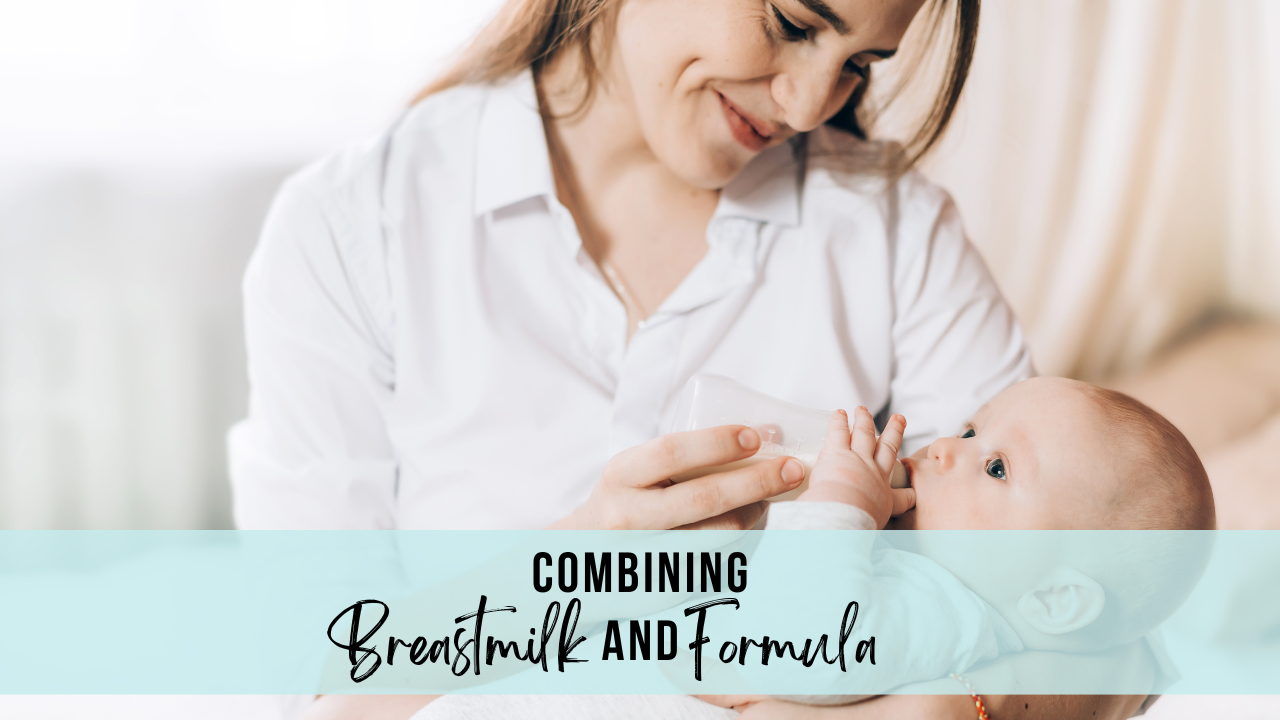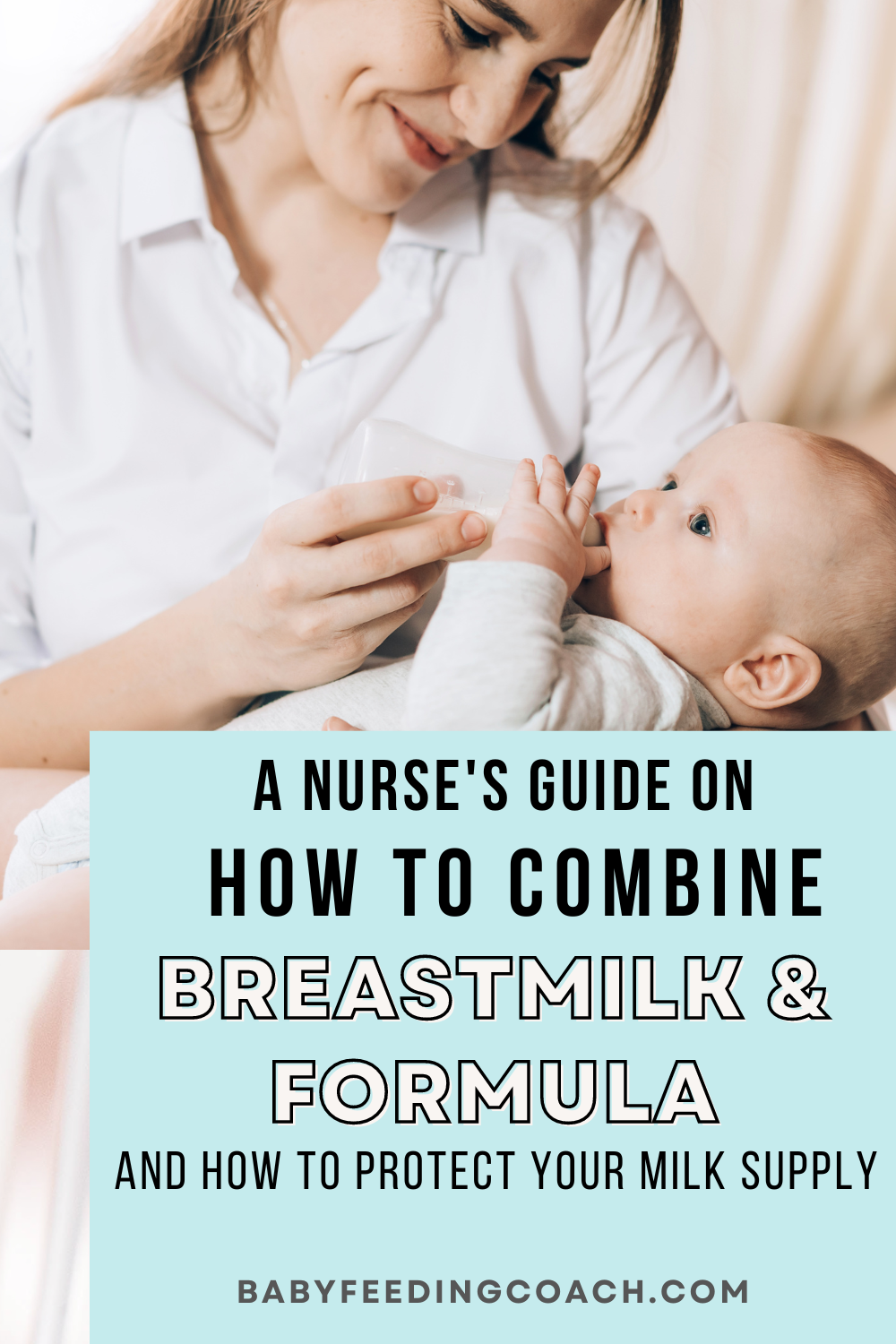Combining Breastmilk and Formula | Combo-Feeding Basics
Nov 01, 2022
Did you know that combo-feeding (combining breast milk and formula) is one of the most common ways that moms feed their babies?
It's true! Feeding your baby seems to be black or white --- you either breastfeed exclusively or formula feed exclusively. In reality, most breastfed babies end up getting formula at some point in their first year of life.
There are great options for combining breastmilk and formula for whatever reason you may have. Combination feeding can take a bit of work depending on individual circumstances and the quantity of milk produced, but it is feasible, I promise!
What is combo-feeding?
Combination feeding (AKA mixed feeding AKA combo-feeding AKA supplementing with formula AKA top-offs) refers to any method of feeding a baby both breastmilk and formula.
Using some formula and some breastmilk is actually a very common way to feed your baby, yet we are not often taught that this is a valid option.
The truth is that combo-feeding is very nuanced. It can be difficult to figure out how to protect your milk supply while offering formula. Even then, mixed feeding is still a valid option that helps many babies grow and thrive.
>>> Do you want to be a confident combination-feeding mom while protecting your milk supply? The Simple Guide to Combination Feeding is the answer to ALL your feeding questions from birth to your baby's first birthday. <<<

Is mixing breastmilk and formula bad?
Unfortunately, this is one of the most common questions that comes up. You may also be wondering what the dangers of mixed feeding are. As with every type of feeding, there are a lot of pros and cons. When choosing whether to combo-feed your baby or not, consider the following:
Pros
-
Combo feeding helps babies gain weight and get important nutrients needed to develop and thrive. If a breastfed baby isn’t getting enough milk from the mother, supplementing can help.
-
Combo feeding can help ease anxiety because you know how much your baby is taking in.
-
Combo feeding lets your partner help! This is a great way for your partner to bond with the baby as well as share some of the load of caring for your baby.
-
As a result of the partner taking on some of the feeds, this gives mama a well-deserved break.
-
Combo feeding can also extend the amount of time breastfeeding can occur. It takes away the "all or nothing" mentality to give families the option of both worlds.
Cons
-
Combo feeding is more work. A baby that is exclusively fed at the breast doesn’t need bottles or formula. It takes time to sterilize the bottles and mix the formula.
-
Combo feeding may lower milk supply. Since breastfeeding typically works on a supply and demand basis, if the breast is not emptied as frequently, milk supply may dip. This is why it is imperative to combo-feed in a way that works to maintain your milk supply.
-
Combo feedings can lead to breast conditions such as blocked ducts, engorgement or mastitis. This is often caused by the breast not being emptied as frequently.
-
Your baby may start to prefer either the bottle or the breast. Some infants will prefer the bottle over the breast once they are exposed to it and vice versa. It’s okay - there are ways to handle this!
How to combine formula and breastmilk
There are three common approaches to mixed feeding:
- Breastfeed first and follow up with a bottle of formula.
- Mix formula and breastmilk into the same bottle (keep on reading for more information about this).
- Give a bottle of breastmilk first and follow it with a bottle of formula.
It mostly comes down to what you prefer and how many bottles you want to clean!
>>> If you want personalized recommendations for your baby, schedule a one-on-one virtual consult to find the best option for you and your baby. <<<
How to protect your milk supply while offering formula
Using only small amounts of formula and frequent milk removal are the best ways to protect your milk supply,
Remember that milk supply is built on a supply and demand system. If you create less demand, there will be less supply.
Pumping when your baby is fed a bottle will help trigger your body to continue making milk to meet the demand.
If your baby is less than three months old, it is recommended to remove milk from the breast 6-10 times per day, even more frequently the younger the baby is. I recommend milk removal 8+ times per day until your milk supply regulates around 6-12 weeks.
For a baby older than 3 months, removing milk around 6+ times a day at regular intervals is recommended.

Can you mix breastmilk and formula in the same bottle?
A question I am often asked is whether it is safe to mix breastmilk with formula. The answer is YES! You can definitely do this as an option for combo feeding.
Many resources say that the only way to combine breastmilk and formula is by offering a bottle of breastmilk and then following up with a bottle of formula.
You can do it this way, but another option is mixing breastmilk and formula in the same bottle.
It does come with a little risk, though. Your baby could refuse the bottle with formula in it, which may result in you needing to throw away precious breast milk. Alternatively, it may help some babies be more accepting of formula when it is combined.
Here is the best practice for combining breast milk and formula in the same bottle...
First, you would mix the formula as directed on the formula container. You then add the breast milk to the bottle, making sure the breast milk is the same temperature as the prepared formula to limit the growth of bacteria.
I have seen a rumor that combining breastmilk and formula decreases the nutrition a baby receives from breastmilk.
There are no studies that suggest combining them will decrease the nutrient profile, so go ahead and combine the two if you'd like. Just remember to follow proper formula storage guidelines.
What is the best formula for combination feeding?
Here is the great news: any formula found on the shelf at the grocery store has been proven to promote infant growth and development. Each baby formula recipe has been reviewed by the FDA and has undergone clinical trials. This means that there isn't necessarily a "best" baby formula.
The best baby formula is one that your baby tolerates and that you feel good about feeding them. It comes down to a matter of preference because no formula will promote more growth or development than any other formula.
>>> Want expert help choosing the best formula for your baby? Click here! <<<
Mixed Feeding Schedules
There is no right way to mix-feed your baby! There is a lot of variance based on age, milk supply, appetite, and weight gain needs. There are a few common ways families make mixed feeding work:
-
You can breastfeed first, then follow up with formula. I always recommend following up with either expressed breastmilk or formula if your baby still seems hungry after a feed.
-
You can also breastfeed most of the time, but select a feed a day to use formula via a bottle.
-
You could also pump on a schedule and offer baby a bottle of breastmilk mixed with formula.
-
You can do any combination of the methods above.
Triple feeding schedules for newborns
The early days of breastfeeding can be very challenging. I see many moms in clinic with feeding concerns. If your milk supply has not transitioned from colostrum to mature milk, it might be necessary to supplement with formula or donor milk.
What does triple feeding mean?
It means that each time your baby is hungry, you breastfeed first and immediately pump afterward while someone else (hopefully) gives your baby a bottle. This ensures your baby's caloric needs are met while your milk supply is not meeting baby's demands. Baby gets more practice at the breast while pumping triggers the brain to make more milk.
Triple feeding is meant to be temporary - usually lasting less than 5 to 7 days. If you need to triple feed or supplement longer to meet your baby's demands, I recommend getting to the root cause of the issue with a visit with a lactation provider. I can also help via a virtual consult.
How combo-feeding worked for my family
Both of my boys were fed breastmilk and formula throughout their first year.
Max was born in January 2020, right before lockdown. There was such limited support at the time. I had oversupply early in pregnancy. Max started sleeping 12 hours (inconsistently) at 12 weeks. Unfortunately, I could not maintain my milk supply even with pumping before bed. He did not gain weight between his 4 to 6-month visits. I would love to say I started formula right away, but instead, I loaded him up on solids which made my milk supply decrease even more. By 7 months, i knew I needed to add in formula.
We combo-fed by directly breastfeeding in the morning. While I was at work during the day, I made bottles with pumped milk and formula. I then directly breastfed before his bedtime and did a dream feed.
Elliot was born in March 2023. Though I had controlled gestational diabetes, his blood sugar was 17. He got glucose gel and I promptly asked for formula while they were busy stitching me up. He was combo-fed through 2 tongue tie revisions, numerous lactation visits, and feeding therapy.
He started refusing bottles around 3 months, which was so stressful when I needed to leave for extended periods. From 5.5 months until he started drinking efficiently from a cup, he received breastmilk and formula via purees while at school and directly breastfed at home. He was mixed-fed until we weaned at one.
It was challenging to figure it out, but it was the best option for my family during both postpartum periods.
Combo-feeding is an excellent way to feed your baby - you get assurance that your baby is getting important calories and you are providing benefits from your breastmilk. It can be daunting when trying to figure it out, so make sure to ask for help when it comes to mixed feeding. I am here when you need me!
>>> Do you want to be a confident combination-feeding mom while protecting your milk supply? Want to know how much formula to offer? The Simple Guide to Combination Feeding is the answer to ALL your feeding questions from birth to your baby's first birthday. <<<

>>> Tired of worrying about feeding your baby? Get personalized support so you can enjoy feeding your baby. <<<
Free Resource for Parents and Medical Providers:
The Baby Formula Database
Helping you understand what formulas are available and narrow down what is best for your family.
This will sign you up for the Baby Feeding Coach email list. I will not spam you. Opt out anytime.




